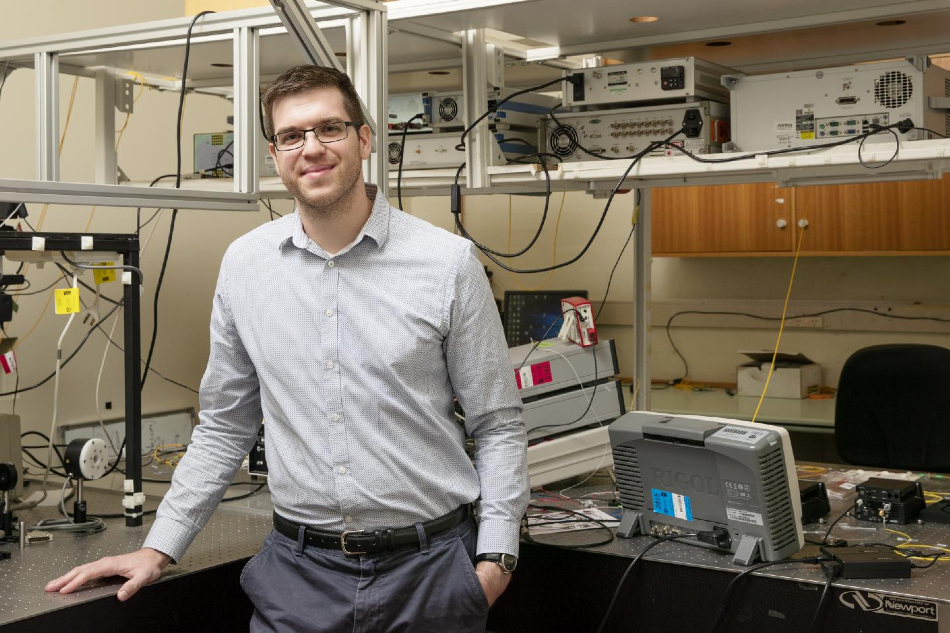May 26 2020
A new kind of laser developed by researchers can deliver high amounts of energy in very short bursts of time. The laser could find prospective applications in the engineering of delicate materials, or eye and heart surgery.
 Lead author Dr Antoine Runge from the School of Physics. Image Credit: Louise Cooper.
Lead author Dr Antoine Runge from the School of Physics. Image Credit: Louise Cooper.
According to Professor Martijn de Sterke, who is the Director of the Institute of Photonics and Optical Science at the University of Sydney, “This laser has the property that as its pulse duration decreases to less than a trillionth of a second, its energy could go through the roof.”
This makes them ideal candidates for the processing of materials that require short, powerful pulses. One application could be in corneal surgery, which relies on gently removing material from the eye. This requires strong, short light pulses that do not heat and damage the surface.
Martijn de Sterke, Professor and Director, Institute of Photonics and Optical Science, University of Sydney
The study was published recently in Nature Photonics.
The researchers could realize such an exceptional result by making use of an already existing, simple laser technology most common in telecommunications, spectroscopy, and metrology. These lasers use an effect called soliton waves—light waves that retain their shape over long distances.
First identified in the early 19th century, solitons were found not in light but in water waves in the industrial canals of England.
“The fact that soliton waves in light maintain their shape means they are excellent for a wide range of applications, including telecommunications and spectrometry,” stated Dr Antoine Runge from the School of Physics, who is the lead author of the study.
Dr Runge added, “However, while lasers producing these solitons are simple to make, they do not pack much punch. A completely different—and expensive—physical system is required to produce the high-energy optical pulses used in manufacturing.”
Soliton lasers are the most simple, cost-effective and robust way to achieve these short bursts. However, until now, conventional soliton lasers could not deliver enough energy. Our results have the potential to make soliton lasers useful for biomedical applications.
Dr Andrea Blanco-Redondo, Study Co-Author and Head of Silicon Photonics, Nokia Bell Labs, United States
Dr Blanco-Redondo was previously associated with the University of Sydney Nano Institute.
This study is based on earlier research performed by the group at the Institute for Photonics and Optical Science of the University of Sydney, which reported its discovery of pure-quartic solitons in 2016.
A New Law in Laser Physics
In the case of a standard soliton laser, the energy of light has an inverse relation to its pulse duration, given by the equation E = 1/t. When the pulse time of the light is halved, twice the amount of energy is obtained.
By contrast, in quartic solitons, the energy of light has an inverse relation to the third power of the pulse duration, i.e., E = 1/t3. This implies that halving the pulse time delivers energy multiplied by a factor of eight in that time.
It is this demonstration of a new law in laser physics that is most important in our research. We have shown that E = 1/t3 and we hope this will change how lasers can be applied in the future.
Dr Antoine Runge, Study Lead Author, School of Physics, University of Sydney
By establishing this proof of concept, the researchers can develop more robust soliton lasers.
According to Dr Blanco-Redondo, “In this research we produced pulses that are as short as a trillionth of a second, but we have plans to get much shorter than that.”
“Our next goal is to produce femtosecond duration pulses—one quadrillionth of a second,” added Dr Runge. “This will mean ultra-short laser pulses with hundreds of kilowatts of peak power.”
“We hope this type of laser can open a new way to apply laser light when we need high peak energy but where the base material is not damaged,” noted Professor De Sterke.
This study was financially supported by the Australian Research Council (ARC) Discovery Project (grant no. DP180102234), the University of Sydney Professor Harry Messel Research Fellowship, and the Asian Office of Aerospace R&D (AOARD) (grant no. FA2386-19-1-4067).
Journal Reference:
Runge, A. F. J., et al. (2020) The pure-quartic soliton laser. Nature Photonics. doi.org/10.1038/s41566-020-0629-6.